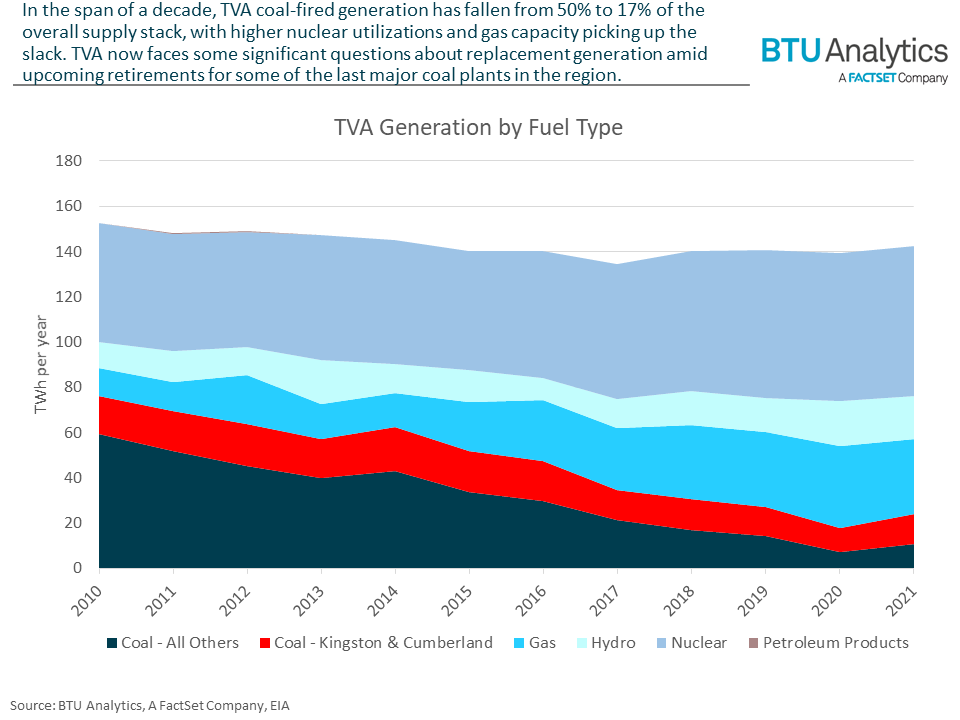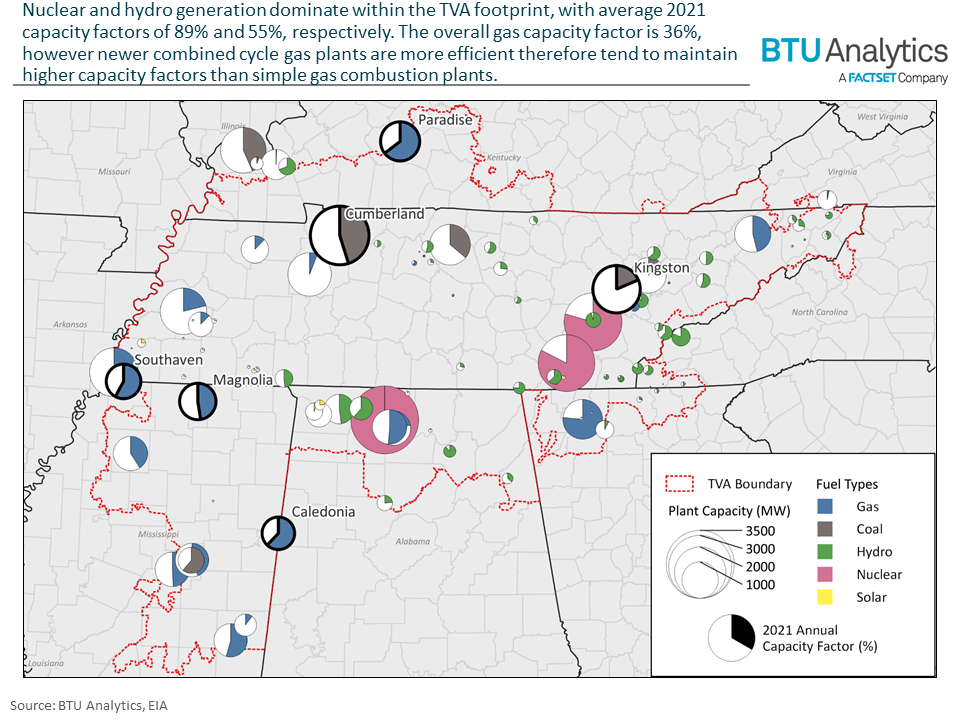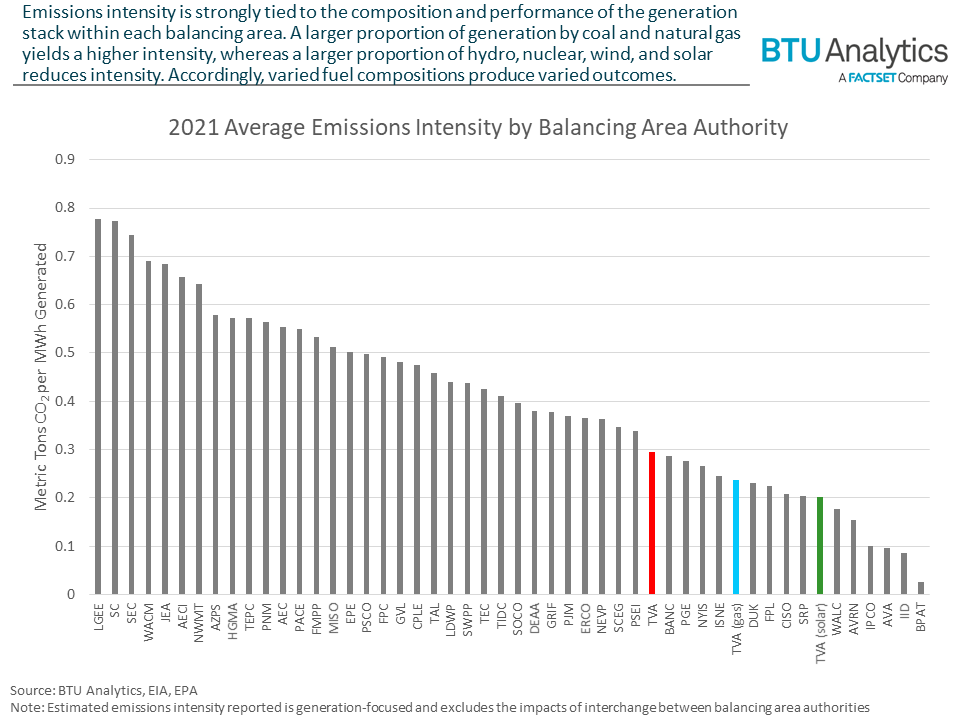At a November 10, 2021, board meeting, TVA’s Chief Operating Officer, Don Moul, reiterated the utility’s strategic intent described in their latest Integrated Resource Plan (IRP) published in 2019. This plan includes phased retirements of 4.3 GW of retiring coal capacity at their Kingston and Cumberland plants with three options to backfill that lost capacity: a combined cycle gas plant option, a transmission upgrade and small-scale gas option, and a solar plus storage option. Today, we’ll look at the combined cycle option that has gained the most traction and how it will affect TVA’s generation profile and emissions intensity.
First, it is helpful to examine the recent historical generation at the Kingston and Cumberland plants to understand the generation that is being lost. In 2021, these plants alone represented a whopping 55% of all coal-fired electrical generation within TVA’s footprint across seven US states. Combined, the plants generated 13.1 TWh in 2021, or over 9% of the total 142.5 TWh generated from all facilities directly owned and operated by the utility.

A review of operational TVA plants in the utility’s balancing area shows a landscape dominated by gas, coal, hydro, and nuclear generation. There is no expectation for any additions to nuclear or hydro capacity for the foreseeable future and only 2.3 GW of solar projects proposed. BTU Analytics estimates that TVA would need approximately three times that much solar generation by 2026 to meet the lost coal generation from the Kingston and Cumberland plants. In addition, a large buildout of energy storage would be required, which has seen little movement to date.
The recent announcements for project development by pipeline operators Enbridge and Kinder Morgan that would see increased natural gas deliverability to the Kingston and Cumberland sites gives credence to the combined cycle option gaining steam. In addition, in October 2021, TVA reported a new generator interconnection request for 1,600 MW of new natural gas-fired generation capacity near Cumberland. The stated in-service dates for both the pipeline expansions and the new Cumberland interconnection request narrowly precede the expected retirement dates for the existing Kingston and Cumberland plants, lending further support to this possibility.
Assuming new combined cycle natural gas plants are constructed to backfill generation after the existing Kingston and Cumberland coal units retire, a look at capacity factors for TVA’s newer Caledonia, Magnolia, Paradise, and Southaven plants may be instructive for estimating the total nameplate capacity needed for these facilities to provide a replacement for retired generation. Based on their generation profile, as shown on the map below, these plants ran at an average capacity factor of 58% during 2021, which implies a need to construct 2.6 GW of new gas capacity to replace both retiring coal plants.

Amid the backdrop of increasing ESG scrutiny directed at utilities across the US, how might the exercise of these different options affect TVA’s overall carbon emissions intensity, and how does TVA’s intensity measure up to its peers? An examination of 40 US balancing area authorities and the seven major US ISOs reveals that TVA is already in the 70th percentile of emissions intensity. Owing largely to its sizable nuclear and hydroelectric generation assets, in 2021 the utility produced an estimated 0.30 metric tons of CO2 per MWh generated. Using 2021 generation as a baseline, in the combined cycle coal replacement scenario TVA’s resulting emissions intensity would fall to 0.24 MT/MWh. Revisiting the solar replacement scenario, this intensity would fall further to 0.20 MT/MWh.

As aging coal plants continue to face retirement in the coming decades, the balancing authorities responsible for procuring sufficient generation to maintain grid reliability will be tasked with navigating the political, regulatory, and economic environment. As authorities embrace the energy transition, a well-rounded view of the emissions consequences for the total generation stack is essential. To explore BTU Analytics’ analysis of generation and emissions, reach out to schedule a demo of the BTU Power View today.








